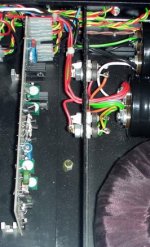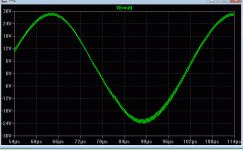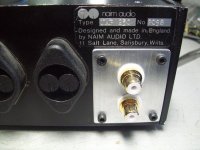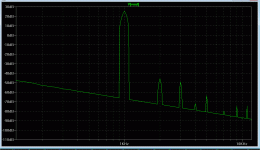Despite the NAP250 circuit not being the most advanced, it does sound nice. And they do seem to last a long time - probably because they are beautifully built. Having said that, I've been mulling the idea of replacing the innards of mine with more modern boards...
i never said that they dont sound nice .... only wonder how nice and compaired to what .
Yet again let us not forget that we talk about a machine the is created very long time ago By far too many things where diferent at the time .
As about lasting for many years i found it very very possible since the actuall circuit is created without electrolytics that is the number one reason of failure in old amplifiers....
Hi Sakis,
there is no Naim amp that gets warm on the touch just by letting it switched on, especially not at 22 degrees ambient temperature. Naims work with a low bias current setting. No need to increase this.
One more thing. Please let us all stay at least a bit subjective when it comes to sound. For many people, Naim amps have a certain kind of musicality, drive and an overall pleasant character. These guys are often more involved with some music made at the time their amps have been made.
Other people are getting more touched by a sound that is more precise, clean and with maximum resolution. A matter of taste. No need to claim "this amp sounds good" or "that amp doesn't".
Regards!
Martin
you are very correct at 30 ma ( recomended bias ) i was wrong from me to expect temperature to rise ...it didnt but at least both bias remains stable after long hours of operation .... that was a good sign
as about listeners of some age that listening to music of some age i can accept the facts you mentioned above and people's evaluation of sonics and colourations
obviously there is people that if you give the a super sharp, super fast ,super slew rate, and super bandwidth amplifier of today they will probably say to you that """ this is a nice amp but its not musical enough """"
been there i know what are you talking about
i am still working on the naim 250 that came in the shop today and will post details of my work and findings till monday ...
From a first look is a terrible machine and sorry to say it has things that i dont like ...
obviously poor choise of LTp and also eventhough thermal coupling was very very possible to do the never did .....Beyond sound improvement from matched LTP thermal coupling will also provide extra stability ...
I am just started so give it a bit of time and see how it goes
Kind regards sakis
"terrible machine"
Very surprised this amp has a " following" , as it would be hard to beat it in a
ill-conceived joke of a design.
Just changing R6=220R - R4=470R and to slightly degenerate Q1/2 and 5
would eliminate the need for r16/19 and c10-11. then you could even get rid of the massive lead comp (c7/r9).I can't imagine what herb the designer was on ....
PS - didn't mean to come down hard on this one ... but the "sound" could easily be beat by anything , unless the subjective "love" of the design clouded the judgement.
OS
Last edited:
Its not only due to low bias that NAIM amps stay cool, its also due to the heat dissipation system chosen.
Those "precise, clean and with maximum resolution" certainly wouldn't be attributes that I would exclude from characterization of NAIM presentation.
Those NAIM amps may add some SS coloration not everybody is happy with - but in terms of all the other high end audio buzz words - no concerns !
And again - I doubt that the intended "upgrades" can do anything to overcome that specific SS colorations.
More likely they will result in destroying a long grown and refined sonic balance.
IMO one would have to dig waaay deeper to make any significant progress sound wise.
Michael
as about the heat sink ...
just a Π shaped thick aluminium is not a "heat dissipation system " its just a piece of Π shaped thick aluminium ..... what keeps the amp cool is low bias ...nothing else
and as about the intented upgrades ...
I think that you are over reacting and think god of NAIM .... which is obviously wrong ...adding a BC546 MAtched and thermally coupled LTP, add a bit of decoupling and bypass , and a better capacitor in the input is not going to change the sonic signature of the amplifier and if it changes after all it will be for the best ....
as about """ long grown and refined sonic balance.""" ....
it seems that you are telling me that NAIM people checked over the years that twisting cables between BCE on the power transitors improoves and refines the sonic balance ....
Well sorry but this is B**** obviously the NAIM people realized that this is wrong and redesign their pcb to feature cans or other transitors bolted on pcb preciselly to avoid the above condition and the side effects from it ( as a million other manufacturers did ) ...
kind regards sakis
dont be surprized OS ...that machine has a long grown and refined sonic balance coming from tantaliums and twisted cables ....
( as said its too hot here in Greece so i hope i am allowed from time to time to make a joke )
Happy regards sakis
But it DOES contradict most of the advice on distortion mechanisms laid down in both B. Cordell's and D. self's handbooks.
I also use the 3281 - 15033/32 pair exclusively , and the design flirts with such a bad choice of compensation that failure is more likely.
perhaps the right speaker/amp combo would mask the shortcomings of the design.
PS- during the 70's mentioned were designs like the m120 luxman , a LIN amp like this properly designed by harmon- kardon , no lack of
topology in this age. At 79-80 JVC "super A"... which sounded awesome..
OS
Last edited:
Hello to all.
Ostripper said
Thank you,
D.
Ostripper said
How much degenaration?Just changing R6=220R - R4=470R and to slightly degenerate Q1/2 and 5
Thank you,
D.
Naim amplifiers use a simple, generic circuit but with proprietary components. The amps produce a sound liked by a lot of people but they cost dearly.
Since the circuit is so simple, a DIYer is actually provoked to try building a “clone” for a fraction of the cost of the real thing. To compensate for the lack of special components, the simplicity of the circuit offers the chance for delicate improvements in an effort to reach the sound of the actual amp as close as possible, without compromising the original design.
As an example, the circuit shows a slew rate of not more than 25V/μs. In most designers’ texts a slew rate of twice this value is recommended. Making the “clone” faster than the original may, sound-wise, shorten the distance from the actual Naim amp.
As a second example consider this. The original Naim amp requires specific cabling towards the speakers. A DIYer may easily remedy this without changing the main philosophy of the design.
A third improvement may be implemented in the area of the power supply. It is almost universally accepted that, the regulated supply which is used in the amp imposes restraints on the capabilities of the circuit. A DIYer might consider an unregulated supply, or even better, a regulated supply for the two first stages and an unregulated supply for the output.
...
All these in an effort to achieve the Naim sound as close as possible.
By the way, has anybody seen in the specs of these Naim amps what the slew rate is? Has anybody (reviewers?) actually measured the slew rate of a NAP 250 or 135.
My best regards to all,
D.
Since the circuit is so simple, a DIYer is actually provoked to try building a “clone” for a fraction of the cost of the real thing. To compensate for the lack of special components, the simplicity of the circuit offers the chance for delicate improvements in an effort to reach the sound of the actual amp as close as possible, without compromising the original design.
As an example, the circuit shows a slew rate of not more than 25V/μs. In most designers’ texts a slew rate of twice this value is recommended. Making the “clone” faster than the original may, sound-wise, shorten the distance from the actual Naim amp.
As a second example consider this. The original Naim amp requires specific cabling towards the speakers. A DIYer may easily remedy this without changing the main philosophy of the design.
A third improvement may be implemented in the area of the power supply. It is almost universally accepted that, the regulated supply which is used in the amp imposes restraints on the capabilities of the circuit. A DIYer might consider an unregulated supply, or even better, a regulated supply for the two first stages and an unregulated supply for the output.
...
All these in an effort to achieve the Naim sound as close as possible.
By the way, has anybody seen in the specs of these Naim amps what the slew rate is? Has anybody (reviewers?) actually measured the slew rate of a NAP 250 or 135.
My best regards to all,
D.
For this I would have to do a closed loop gain/ open loop gain plot of it. I would also have to have reliable models of those zetex's.
First you would have to simulate it fully. (I did generalize)
I'll do it ... and keep the basic design as close to it's simple form as is "humanly possible" (look up the zetex's - find the closest fairchild/toshiba's I can).
I need the exercise , I have a pile of 15024 to-3's .... need to make me a quasi amp
OS
First you would have to simulate it fully. (I did generalize)
I'll do it ... and keep the basic design as close to it's simple form as is "humanly possible" (look up the zetex's - find the closest fairchild/toshiba's I can).
I need the exercise , I have a pile of 15024 to-3's .... need to make me a quasi amp
OS
proprietary components. ????
zetex vas= 140Vceo 100mhz ft 30pf Cob
Run of the mill BC239 LTP
Standard OP stage , passives look conventional.
just googled ... looked at PCB's ,components , completed amps. Nothing special.
Just doug self's first LIN amp example before he addresses getting rid of oblivious
distortion mechanisms with simple design augmentations.
OS
zetex vas= 140Vceo 100mhz ft 30pf Cob
Run of the mill BC239 LTP
Standard OP stage , passives look conventional.
just googled ... looked at PCB's ,components , completed amps. Nothing special.
Just doug self's first LIN amp example before he addresses getting rid of oblivious
distortion mechanisms with simple design augmentations.
OS
As I have said here at this forum quite often: Almost all the people who critize thee NAIM amps with this argument or another have never listened with them. Nor do they have any real experience with those amps.
As many of the points brought up here and in other threads, these amps nevertheless sound very good, and even the latest NAIM amps have many details in common with their heirs. They are sold in great numbers inspite of their high prices and loved by reviewers and home and professionals listeners alike. So?
As many of the points brought up here and in other threads, these amps nevertheless sound very good, and even the latest NAIM amps have many details in common with their heirs. They are sold in great numbers inspite of their high prices and loved by reviewers and home and professionals listeners alike. So?
LT says
-22V/us slew
-.08 -.1% 40vp-p THD20
-.03% 40v p-p 1k
-Only conditionally stable....
2sa1381 is 7pf vs 20pf (zetex) 100hfe , just about the same
2sc1845 is essentially the same as the BC239's 200Hfe 100mhz ft.
I would say whatever "unique sound" this has is the result of being designed wrong (intentional) , brought to the edge of instability, or over it. (hence the special wiring arrangements).
These flaws(or enhancements) do nothing for making the amp faster (it isn't)
It does oscillate with my slightly faster models .... 33r VAS degen. makes it work for the tests.
I used this schema - http://www.acoustica.org.uk/t/naim/poweramp_pix/NAP250%20schematic.jpg
for my simulations.
PS - this design is so simple it works WELL while oscillating. cool....
OS
-22V/us slew
-.08 -.1% 40vp-p THD20
-.03% 40v p-p 1k
-Only conditionally stable....
2sa1381 is 7pf vs 20pf (zetex) 100hfe , just about the same
2sc1845 is essentially the same as the BC239's 200Hfe 100mhz ft.
I would say whatever "unique sound" this has is the result of being designed wrong (intentional) , brought to the edge of instability, or over it. (hence the special wiring arrangements).
These flaws(or enhancements) do nothing for making the amp faster (it isn't)
It does oscillate with my slightly faster models .... 33r VAS degen. makes it work for the tests.
I used this schema - http://www.acoustica.org.uk/t/naim/poweramp_pix/NAP250%20schematic.jpg
for my simulations.
PS - this design is so simple it works WELL while oscillating. cool....
OS
Attachments
Last edited:
Did you change main PSU capacitors yet? Has it ever been refreshed for those? Also the MR2002 can be still fit or not, depends on what kind of use it had seen for on/off cycles.
Thanks for the interest Salas .... sorry to say i am not there yet as said only
----the ltp is replaced
----better cap in the input
---- VI limiter removal
---- bit of decoupling and bypass
---- multiturns for the idle
---- and first picture of ofset and idle
As we speak i will dare to play on the risky side and with danger to degrade and compromize the sonic signature ,and the long grown and refined sonic balance i did this ....
Attachments
I would say whatever "unique sound" this has is the result of being designed wrong (intentional) , brought to the edge of instability, or over it. (hence the special wiring arrangements).
These flaws(or enhancements) do nothing for making the amp faster (it isn't)
It does oscillate with my slightly faster models .... 33r VAS degen. makes it work for the tests.
It wasn't intentionally flawed, its just done in 1975 by an enthusiast.
I would also add that the R/C driver network in the schema is specifically designed to interact with the Cob of the NIAM drivers , another possibility that it does work and has a specific sound.
The "massive" phase lead NFB network also is device specific.
Changing driver models will totally change the loop response and stability margins of this amp.
PS- so there might be "method to the madness". But .... not a DIY friendly design , too dependant on the specs of specific devices.
sort of like " the best amp in the world" (goldmund clone) ... lots of initial interest .... then it fades away.....
OS
The "massive" phase lead NFB network also is device specific.
Changing driver models will totally change the loop response and stability margins of this amp.
PS- so there might be "method to the madness". But .... not a DIY friendly design , too dependant on the specs of specific devices.
sort of like " the best amp in the world" (goldmund clone) ... lots of initial interest .... then it fades away.....
OS
Last edited:
As we speak i will dare to play on the risky side and with danger to degrade and compromize the sonic signature ,and the long grown and refined sonic balance i did this ....
It all depends on the owner's kind of directions given. If its a modernization and maintenance note at will, you do well to make it more communicative for interconnection even.
- Status
- This old topic is closed. If you want to reopen this topic, contact a moderator using the "Report Post" button.
- Home
- Amplifiers
- Solid State
- Naim Nap 250 (135) specs



